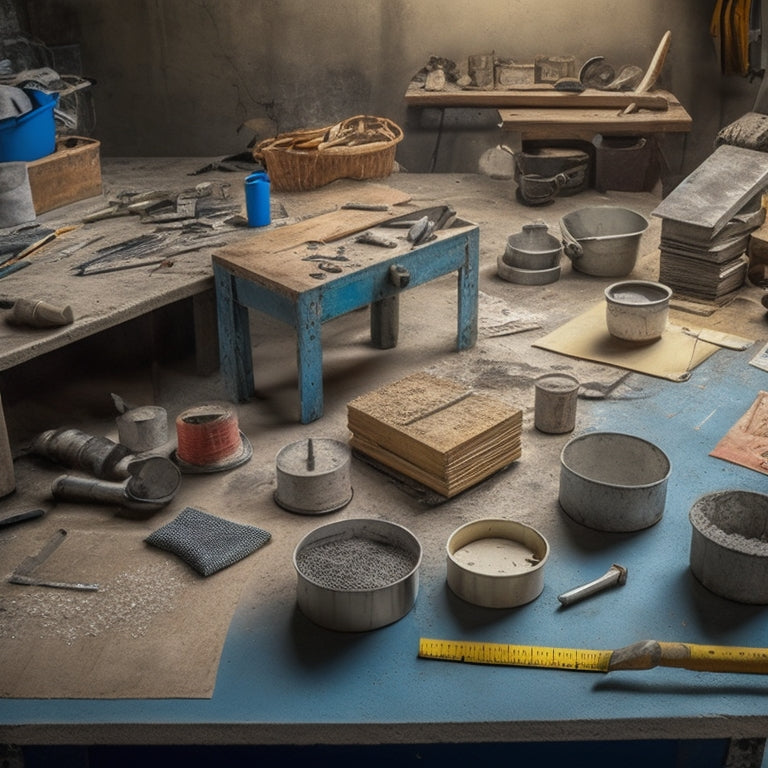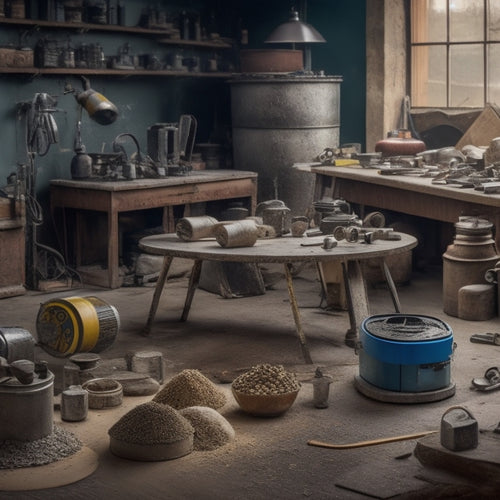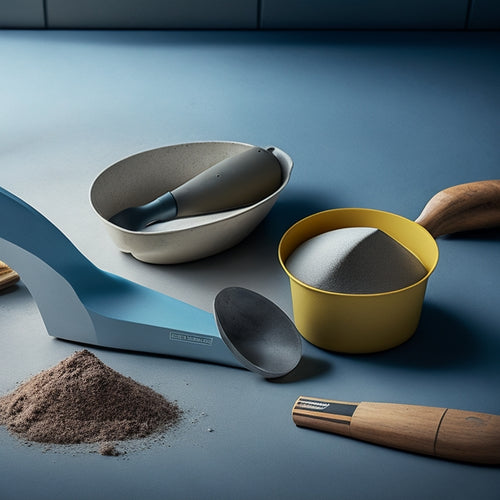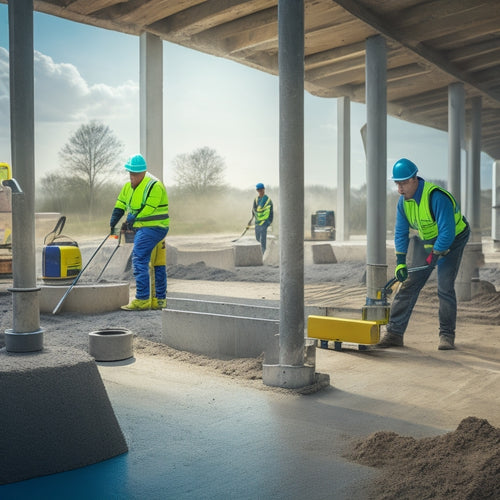
What Tools Do I Need for Stamped Concrete
Share
You'll need a range of tools to achieve professional-looking stamped concrete results. Essential hand tools include a tamper, edger, jointer/groover, and texturing skin/stamp mat. For pattern imprinting, you'll require a variety of tools, such as texture mats and rigid stamping tools, and consider design aspects like scale and aesthetic goals. Additionally, you'll need texturing and finishing tools, like tamping tools and finishing trowels, as well as safety gear, including gloves, safety glasses, and a dust mask. With the right tools, you'll be well on your way to creating stunning, realistic designs - and exploring the nuances of each tool will help you take your projects to the next level.
Key Takeaways
• Essential hand tools for stamping concrete include tampers, edgers, jointers/groovers, texturing skins/stamp mats, and tool maintenance equipment.
• Pattern imprinting requires a variety of tools, such as texture mats, stamp mats, and rigid stamping tools, to achieve diverse effects.
• Texturing and finishing tools, including tamping tools, finishing tools, edging tools, and finishing trowels, are necessary for a professional finish.
• Safety gear, such as gloves, safety glasses, dust masks, and rigorous protection, is critical for personal safety while working with concrete.
• Specialized tools, like stamp mats, color application tools, texture skins, stencil systems, and precision hand tools, can be used to create custom designs and realistic effects.
Essential Hand Tools for Stamping
When stamping concrete, you'll need a set of essential hand tools to achieve the desired pattern and texture. These tools will help you master various imprint techniques, guaranteeing a professional-looking finish.
First, you'll need a tamper, which is used to compact and level the concrete. An edger will help you create clean, defined edges, while a jointer or groover will allow you to create control joints and patterns. A texturing skin or stamp mat is also necessary for creating the desired texture and pattern.
To make sure your tools remain in top condition, regular tool maintenance is vital. Clean your tools thoroughly after each use, and store them in a dry place to prevent rust. You should also lubricate moving parts and sharpen tools as needed.
Pattern Imprinting Tool Essentials
By investing in an extensive set of pattern imprinting tools, you'll be able to replicate a wide range of textures and patterns, from natural stone to wood grain, and achieve a realistic, high-end finish. These tools are specifically designed to create intricate patterns and textures on freshly poured concrete. You'll need a variety of tools to achieve different effects, including texture mats, stamp mats, and rigid stamping tools.
When selecting pattern imprinting tools, consider the specific design you're trying to achieve. For example, if you're going for a natural stone look, you'll want to choose tools with irregular patterns and subtle texture variations. Pattern selection tips include considering the scale of the pattern, the color and texture of the concrete, and the overall aesthetic you're trying to achieve.
Mastering imprinting techniques takes practice, but with the right tools and a bit of patience, you can achieve professional-looking results. Start by practicing on small test areas to get a feel for the tools and the concrete. As you become more confident, you can move on to larger areas and more complex designs.
Texturing and Finishing Tools
You'll need a range of texturing and finishing tools to refine your stamped concrete design and achieve the desired level of texture and sheen. These tools will help you master various texturing techniques, from subtle to dramatic, and apply finishing methods that enhance the appearance of your concrete.
For texturing, you'll need tools like texture mats, stamp mats, and stamp tools. These will allow you to create patterns, designs, and textures that mimic natural stone, wood, or other materials. You may also use tamping tools to compact and level the concrete, ensuring a smooth finish.
When it comes to finishing, you'll need tools like sealers, waxes, and polishing compounds. These will help protect your concrete from the elements, enhance its color and luster, and create a durable, low-maintenance surface.
Additionally, you may use edging tools to create clean, defined edges and joints, and finishing trowels to smooth out the surface.
Safety Gear for Concrete Work
Protecting yourself from the hazards associated with concrete work is crucial, so don't start a project without essential safety gear like gloves, safety glasses, and a dust mask. You'll be working with harsh chemicals, heavy materials, and power tools, which can cause serious injuries if you're not properly protected.
Invest in durable gloves that can withstand the rigors of concrete work. Look for gloves with grip, flexibility, and puncture resistance to guarantee you can handle tools and materials safely. Your hands are your most valuable asset, so don't take any chances.
Protective eyewear is also a must-have. Safety glasses or goggles will shield your eyes from flying debris, chemical splashes, and other hazards. Make sure they fit snugly and provide clear vision.
A dust mask is another essential item to prevent inhaling concrete dust and other airborne particles. It's better to be safe than sorry, so don't skip on these critical safety gear.
Specialized Tools for Designs
As you explore the world of stamped concrete, specialized tools become essential for bringing your design vision to life, allowing you to achieve intricate patterns, textures, and shapes that set your work apart.
To master various design techniques, you'll need tools that can help you create unique effects. For instance, stamp mats with different patterns and textures will enable you to achieve realistic stone, wood, or tile designs. You'll also need specialized tools for color application, such as color hardeners, release agents, and acid stains, to add depth and dimension to your designs.
Other essential tools include texture skins, which can mimic the look of natural stone or rock, and stencil systems, which allow for custom logos or designs.
Additionally, you'll need a set of precision hand tools, such as trowels, edgers, and jointers, to refine your design and add fine details.
With these specialized tools, you'll be able to experiment with different design techniques, push the boundaries of color application, and bring your unique vision to life.
Frequently Asked Questions
Can I Use a Regular Concrete Mix for Stamped Concrete?
You're wondering if you can use a regular concrete mix for stamped concrete. The answer is, it's not recommended.
Regular mixes lack the necessary workability and strength for stamped concrete.
You'll need a specialized mix with concrete additives that enhance its flowability, flexibility, and durability.
These additives will help you achieve the desired texture and pattern.
How Do I Maintain and Clean My Stamping Tools?
You're the master of your stamped concrete domain, but even the best tools can't perform magic without proper care.
To keep your stamping tools in top shape, you'll need to store them in a dry, clean area, protected from the elements.
Regularly clean your tools with gentle cleaning solutions to prevent rust and corrosion. A soft-bristled brush and mild soap can work wonders.
What Is the Ideal Temperature for Stamping Concrete?
When you're perfecting your stamping techniques, temperature plays a vital role.
You'll want to work within the ideal temperature range of 50°F to 70°F (10°C to 21°C) for best results.
If it's too hot, the concrete will set too quickly, making it difficult to achieve the desired pattern.
On the other hand, if it's too cold, the concrete won't set fast enough, leading to blurred patterns.
Can I Stamp Concrete in the Rain or High Winds?
You're trying to stamp concrete like a drummer in a rainstorm, but it's essential to prioritize weather considerations for best results.
Stamping in the rain or high winds is a recipe for disaster, compromising stamping safety and the final product's quality.
Water can seep into the mixture, causing unevenness, and strong gusts can disrupt the stamping pattern.
Play it safe and schedule your project for calm, dry conditions to guarantee a flawless finish.
How Long Does It Take to Master Stamping Concrete Techniques?
You'll be relieved to know that mastering stamping techniques doesn't take a lifetime.
With consistent practice, you'll develop the skills you need in a few months to a year.
Focus on perfecting one pattern at a time, and you'll be stamping like a pro in no time.
As you gain confidence, you'll refine your technique, and your work will speak for itself.
Conclusion
As you wrap up your stamped concrete project, think of yourself as a master chef, having carefully mixed the ingredients and added the perfect seasonings.
Now, it's time to plate your dish - the final product, a work of art that showcases your skill and creativity.
With the right tools, you've transformed a blank canvas into a masterpiece, ready to be devoured by the eyes of all who behold it.
Your hard work will be the recipe for a beautiful, long-lasting finish.
Related Posts
-

Top DIY Concrete Grinding and Polishing Tools
When selecting DIY concrete grinding and polishing tools, you'll want to take into account a range of factors to guar...
-

Ergonomic Concrete Tools for Tight Spaces
When you're tackling concrete work in tight spaces, ergonomic tools are your best bet for comfort and efficiency. The...
-

What Tools Ensure Precise Concrete Leveling Results
You need a range of specialized tools to achieve precise concrete leveling results. Laser leveling instruments provid...


